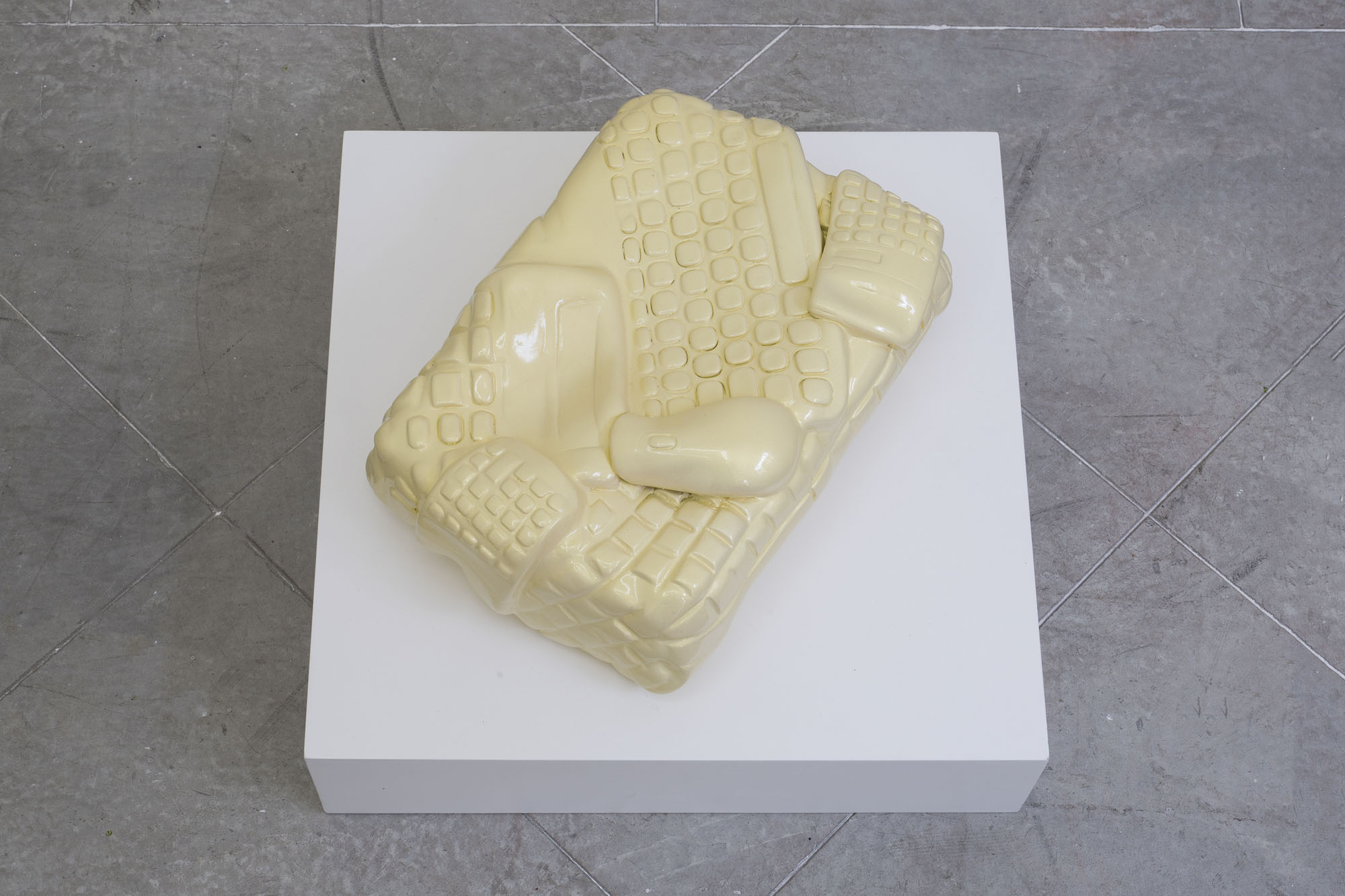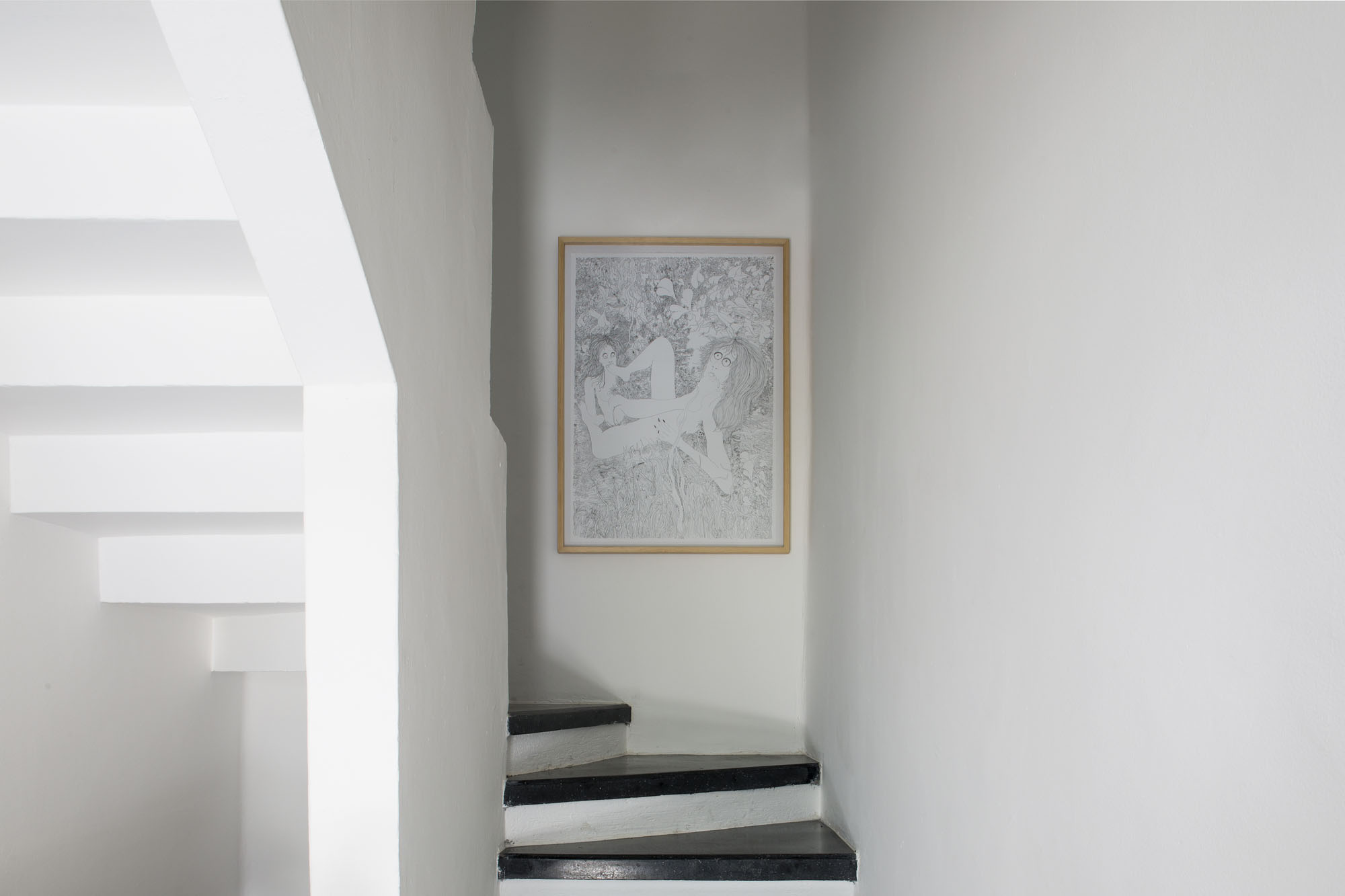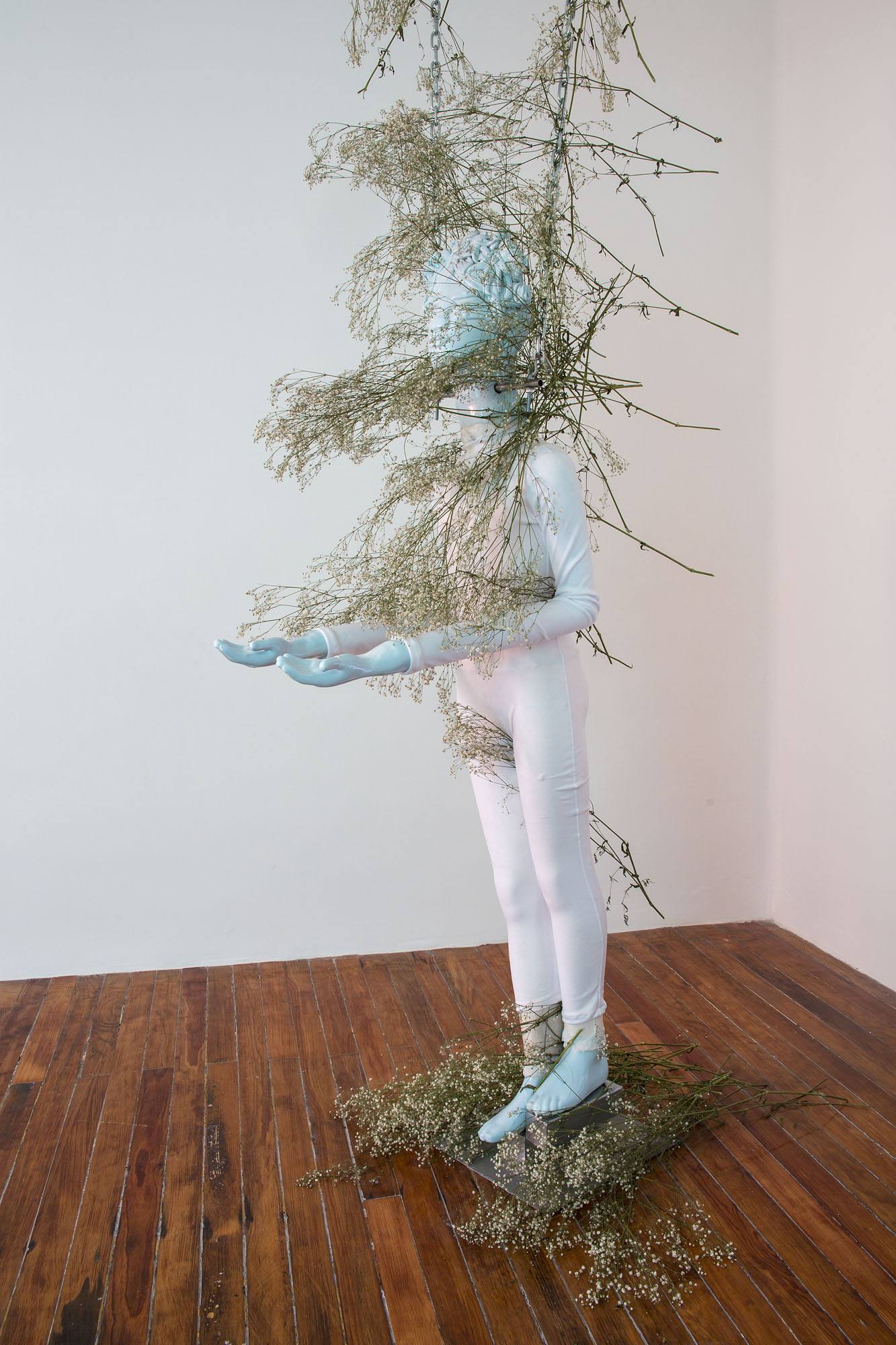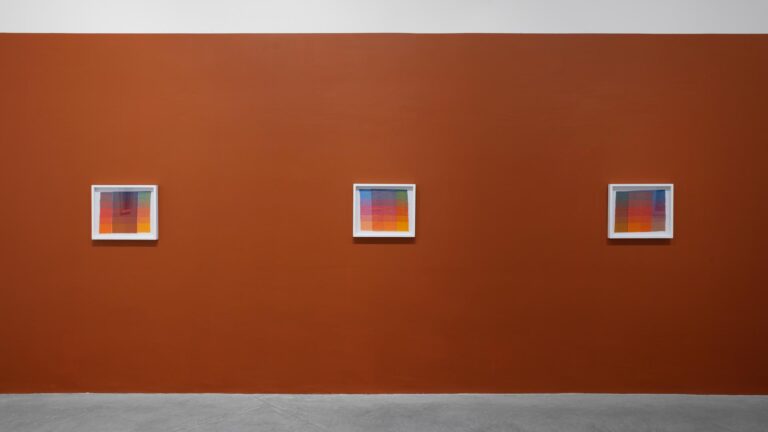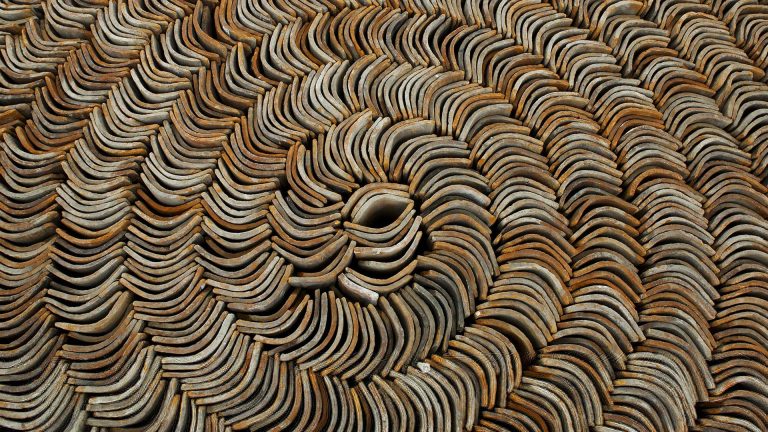Artist: Cristina Tufiño
Exhibition title: Dancing At The End of The World
Venue: Galería Agustina Ferreyra, Mexico City, Mexico
Date: August 31 – October 19, 2019
Photography: all images copyright and courtesy of the artist and Galería Agustina Ferreyra, Mexico City
Dancing at the end of the world, Cristina Tufiño at Galería Agustina Ferreyra Catalogue essay, Ren Ellis Neyra, « Xuxa, Medusa »
Medusa is a lesbian icon. Medusa’s head enacts aesthetic judgment. In my version of the myth, Athena comes across as a cruel whyte bitch, on the level of a Camille Grammar. Who defends Brett Kavanaugh. Poseidon raped Medusa in Athena’s temple. And Athena punished Medusa for being raped—freezing her meaning in that terrifying moment of physical, ontological, and spiritual invasion. Athena cursed her beauty by morphing Medusa’s wavy locks into live snakes. But Medusa’s pricking mirada undulates with plurality, a Man-killer. Tentacular tendrils dentata, hydra-halo of many small eyes: what horrifies Man protects women. Which, in part, is why Medusa is reclaimed as a lesbian icon, where lesbian has to do with women desiring women, yes, and as much to do with the role of queerly hot anti-hero who resignifies, disperses, and undoes the phallus in an episteme that punishes women for their desires and for Man’s bad behavior.
Would that Lorena Bobbitt wore a talisman of Medusa on her neck when John Wayne raped her the first time—if not before. Medusa, guarde corps. His extremely average white penis— an icon of normative, heterosexual banality’s violence—would not have wound-up severed from its demon host, tossed by Lorena into a field of grass. And the red-handled knife? (No one focuses on where it landed.) It may have remained sheathed in Lorena’s kitchen, rather than in a public trashcan on a stack of flattened, red and white striped KFC boxes. Grassy limp junk, a common kitchen knife encircled by bone-in remainders of wormy gringo chicken, and an injured Latina coming to her senses, driving through the rock-and-brambly Virginia night to her nail salon job: a constellation. At the sight of Medusa on Lorena’s talisman, John Wayne, who possessed a form that gets away with murder when called domestic abuse, turned into stone. A permanently useless erection. His own epitaph. If this story had aired, perhaps a then-9 or 10-year-old Cristina Tufiño, living with her abuela, the medievalist scholar, Pilar, on Calle Tetuán in Viejo San Juan, on the Caribbean volcanic afterlife that is Puerto Rico, would have seen the mythic news report on the color TV: Medusa talisman petrifies Lorena Gallo Bobbitt’s husband-rapist. In awe at this rupture of history and myth, Tufiño might have begun sculpting and firing ceramic horrified rapists.
Instead, she tuned-in to Xou da Xuxa and, later, Yves Saint Laurent’s epic pre-fin-de-siècle deployment of hundreds of women models at the Stade de France, marching across a grassy field of clouded blue sky in the same year Ricky Martin exploded with “Copa de vida.” Flexing sculptures. Which is to say, Tufiño’s aesthetic metonymizes not Man’s horror, but women’s creaturely, dark, and cute pleasures.
Her ceramics, in particular, render cuteness—or, pose as ruminations on cuteness. Cute meaning not just a thing we say about things, but a thing (lodged in things) that says something about how we talk about ourselves as homo sapiens, about commodities, and about aesthetics. Cuteness flashes in moments that reference feminine commodities in the elegiac video-letter, Querida Pilar. Whereas in the pencil drawings of wild-haired, maenadic women pleasuring themselves, a near-horror vacui summons the poetic and sensorial fear of empty space, a dark fear in the western hemisphere’s coloniality both of being without images and of being with nature’s untamable imaging. Agog with dendrophilic and spriessen arousal, the wild-haired women tongue each other’s expanding toes; the femme digs her painted, pointy Jenny Bui nails into the soil; their legs converge with the flora that exists on/ in the same lines as the women. (Are these Donna Haraway’s Camilles?) We are in nature, meaning, it knows our perils and our pleasures. Another drawing incorporates a post-human cock with an ambivalent kitty’s squish face as its swollen head. (Who is harder to please than a cat? Whose pleasure more treasured?) In this illustrated but un-narrated fairytale, the cock is not cut off, and has not violently aggressed, but, relieved of a world of John Waynes, has metamorphosed. An invisible body supine, stroked in some fable garden, meows.
While there is not a ceramic sphinx in this exhibition, many inhabit Tufiño’s corpus, including in Querida Pilar. One ceramic Sphinx wears sunglasses—a la Elizabeth Eckford and Posh Spice. What is she looking at? What does her silence know? What does her re-interiorized gaze un-do? And what do we make of a Sphinx that is cute? (Its own riddle.) Cuteness “aestheticiz[es] powerlessness,” literary and art critic Sianne Ngai argues. In the history of the horror that is (white) Man, cuteness that has played in the dark protects and re-imagines the practices, shapes, and textures of women’s material and creaturely pleasures. Cuteness, a “commodity aesthetic,” combines the “conflicting feelings” of “tenderness and aggression.” Tender etymologically connects to tendrils, sprawling young shoots, whereas aggredi evokes a linear walking-toward set-on attack—their entanglement in cuteness is fraught.
Post-Y2K Sphinxes, tentacular horny feet on tacos, post-1492-women’s tendril-foot-fetishes foreplay, stripper heels one size too small and long toes swollen from dancing for his lap, or computer screen, anyways for her pleasure, broken marshmallowed keyboard paeans to dissociation, anti-enlightenment subjectivity, and The Internet as the everywhere and nowhere-place of our propter nos—oh, and kitties—feline companions to internet glow cruises and protectors against trolls: these objects and their forms render cute and grim, innocent and devilish critiques of commodification with swerves of desire. Amulets of fired stories about internet cathexis, ghosted. Relics of a living-dead http://world.net where some people seem to think it’s all just now ending. Which begs the question, What is their historical memory of 1492? And before? And after? Of Cartagena and Isla de Cabras? When have you ever danced for the revolution and it wasn’t after the end of the world?
Sharp tips: the five points of Tufiño’s halogen-glow pentacle protect especially the lusty femme onlooker with evocations of Xuxa, Lorena, the chthulucene, sex workers, and the hundreds of militant heavenly bodies on the soccer pitch in Stade de France cutting the rug inside your outdated TV. If you add up the points, there’s Medusa again.
Cristina Tufiño, Dancing At The End of The World, 2019, exhibition view, Galería Agustina Ferreyra, Mexico City
Cristina Tufiño, Dancing At The End of The World, 2019, exhibition view, Galería Agustina Ferreyra, Mexico City
Cristina Tufiño, Dancing At The End of The World, 2019, exhibition view, Galería Agustina Ferreyra, Mexico City
Cristina Tufiño, Dancing At The End of The World, 2019, exhibition view, Galería Agustina Ferreyra, Mexico City
Cristina Tufiño, Dancing At The End of The World, 2019, exhibition view, Galería Agustina Ferreyra, Mexico City
Cristina Tufiño, Dancing At The End of The World, 2019, exhibition view, Galería Agustina Ferreyra, Mexico City
Cristina Tufiño, Dancing At The End of The World, 2019, exhibition view, Galería Agustina Ferreyra, Mexico City
Cristina Tufiño, Cubetas del Atardecer, 2019, Glazed ceramic, flowers, variable dimensions
Cristina Tufiño, Cubetas del Atardecer, 2019, Glazed ceramic, flowers, variable dimensions
Cristina Tufiño, Cubetas del Atardecer, 2019, Glazed ceramic, flowers, variable dimensions
Cristina Tufiño, Cubetas del Atardecer, 2019, Glazed ceramic, flowers, variable dimensions
Cristina Tufiño, Saint Lisieux, 2019, Glazed ceramic, 26 x 7 x 4 cm, 10.23 x 2.75 x 1.57 inches
Cristina Tufiño, Saint Lisieux, 2019, Glazed ceramic, 26 x 7 x 4 cm, 10.23 x 2.75 x 1.57 inches
Cristina Tufiño, Saint Lisieux, 2019, Glazed ceramic, 26 x 7 x 4 cm, 10.23 x 2.75 x 1.57 inches
Cristina Tufiño, Saint Lisieux, 2019, Glazed ceramic, 26 x 7 x 4 cm, 10.23 x 2.75 x 1.57 inches
Cristina Tufiño, Cubetas del Atardecer (Purple Tower), 2019, Glazed ceramic, variable dimensions
Cristina Tufiño, Cubetas del Atardecer (Purple Tower), 2019, Glazed ceramic, variable dimensions
Cristina Tufiño, Mr. Sister, 2019, Lumina and glazed ceramic, 20 x 20 x 36 cm, 7.87 x 7.87 x 14.17 inches
Cristina Tufiño, Mr. Sister, 2019, Lumina and glazed ceramic, 20 x 20 x 36 cm, 7.87 x 7.87 x 14.17 inches
Cristina Tufiño, Peppermint Hippo (5), 2019, Glazed ceramic, 22 x 21 x 25 cm, 8.66 x 8.26 x 9.84 inches
Cristina Tufiño, Cubetas al atardecer (Baby Blue), 2019, Glazed ceramic, 7 x 5 x 6 cm, 2.75 x 1.96 x 2.36 inches
Cristina Tufiño, Cubetas del Atardecer, 2019, Glazed ceramic, flowers, variable dimensions
Cristina Tufiño, Cubetas del Atardecer, 2019, Glazed ceramic, flowers, variable dimensions
Cristina Tufiño, THELEMA, 2019, ceramic, pigment, 21 X 32 X 10 cm, 8.26 x 12.59 x 3.93 inches
Cristina Tufiño, HUGS, 2019, ceramic, pigment, 29 X 14 X 37 cm, 11.41 x 5.51 x 14.56 inches
Cristina Tufiño, Bocaccio, 2019, ceramic, pigment, 39 X 33 X 9 cm, 15.35 x 12.99 x 3.54 inches
Cristina Tufiño, Ace of Pentys, 2019, Neon sign, 115 x 115 cm, 45.27 x 45.27 inches
Cristina Tufiño, Meow 2, 2019, Ink on paper, 58 x 79 cm, 22.83 x 31.10 inches, Framed
Cristina Tufiño, Dancing At The End Of The World, 2019, Lumina, 76 x 23 x 22 cm, 29.92 x 9.05 x 8.66 inches
Cristina Tufiño, Dancing At The End of The World, 2019, exhibition view, Galería Agustina Ferreyra, Mexico City
Cristina Tufiño, Bad Kitty, 2019, Ink on paper, 79 x 58 cm, 31.10 x 22.83 inches, Framed
Cristina Tufiño, Progeny, 2019, Ink on paper, 78 x 108 cm, 30.70 x 42.51 inches, Framed
Cristina Tufiño, Dancing At The End of The World, 2019, exhibition view, Galería Agustina Ferreyra, Mexico City
Cristina Tufiño, Le Diable, 2019, Ink on paper, 84 x 120 cm, 33.07 x 47.24 inches, Framed
Cristina Tufiño, Dancing At The End of The World, 2019, exhibition view, Galería Agustina Ferreyra, Mexico City
Cristina Tufiño, Dancing At The End of The World, 2019, exhibition view, Galería Agustina Ferreyra, Mexico City
Cristina Tufiño, Dancing At The End of The World, 2019, exhibition view, Galería Agustina Ferreyra, Mexico City
Cristina Tufiño, Dancing At The End of The World, 2019, exhibition view, Galería Agustina Ferreyra, Mexico City
Cristina Tufiño, Ace of Pentys, 2019, Neon sign, 115 x 115 cm, 45.27 x 45.27 inches
Cristina Tufiño, Dancing At The End of The World, 2019, exhibition view, Galería Agustina Ferreyra, Mexico City
Cristina Tufiño, Dancing At The End of The World, 2019, exhibition view, Galería Agustina Ferreyra, Mexico City
Cristina Tufiño, Dancing At The End of The World, 2019, exhibition view, Galería Agustina Ferreyra, Mexico City
Cristina Tufiño, Dancing At The End of The World, 2019, exhibition view, Galería Agustina Ferreyra, Mexico City
Cristina Tufiño, Dear Pilar, 2019, HD Video. Color, Sound, Subtitled, Rt | 7:28 minutes
Cristina Tufiño, Dear Pilar, 2019, HD Video. Color, Sound, Subtitled, Rt | 7:28 minutes
Cristina Tufiño, Dancing At The End of The World, 2019, exhibition view, Galería Agustina Ferreyra, Mexico City
Cristina Tufiño, Progeny, 2019, Ink on paper, 78 x 108 cm, 30.70 x 42.51 inches, Framed
























